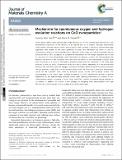Mechanism for spontaneous oxygen and hydrogen evolution reactions on CoO nanoparticles
Author(s)
Park, Kyoung-Won; Kolpak, Alexie M.
Downloadc8ta11087e.pdf (1.191Mb)
PUBLISHER_CC
Publisher with Creative Commons License
Creative Commons Attribution
Terms of use
Metadata
Show full item recordAbstract
Overall photocatalytic water splitting with a high efficiency of ~5% has recently been observed for CoO nanoparticle suspensions in the absence of an applied bias or co-catalyst. Although experimental measurements indicate that the overall photocatalytic water splitting is caused by optimal band edge alignments with respect to the redox potentials of water, the mechanism by which H[subscript 2] and O[subscript 2] simultaneously evolve on these nanoparticles is unknown. In this study, we used first-principles density functional theory (DFT) calculations to elucidate the mechanisms for the charge separation and H[subscript 2] and O[subscript 2] evolution on CoO nanoparticles under illumination in aqueous solution. We demonstrated that electrons are driven to the CoO(100) facet and holes are driven to the hydroxylated CoO(111) facet (OH*–CoO(111)) as a result of the built-in potential arising from the difference in the band edge positions on the two facets. Furthermore, based on a set of criteria, depending on if the photoexcited electrons and holes have sufficient energy to overcome the kinetic barrier along the H[subscript 2] and O[subscript 2] evolution
reaction pathways, respectively, on the relevant surface facet, we show that H2 evolution preferentially occurs on the CoO(100) facet, while O[subscript 2] evolution occurs on the OH*–CoO(111) surface. Our understanding of the overall water splitting mechanism on CoO nanoparticles provides a general explanation for the experimentally observed overall water splitting phenomena on a variety of selfstanding photocatalysts, including g-Ga2O[subscript 3], Cu[subscript 2]O, and KTaO[subscript 3], without an external driving potential or co-catalyst. In addition, we provide a new strategy for designing novel photocatalysts with high efficiency by controlling their surface configurations and morphologies.
Date issued
2019-02Department
Massachusetts Institute of Technology. Department of Materials Science and Engineering; Massachusetts Institute of Technology. Department of Mechanical EngineeringJournal
Journal of Materials Chemistry A
Publisher
Royal Society of Chemistry
Citation
Park, Kyoung-Won, and Alexie M. Kolpak. “Mechanism for Spontaneous Oxygen and Hydrogen Evolution Reactions on CoO Nanoparticles.” Journal of Materials Chemistry A, 2019.
Version: Final published version
ISSN
2050-7488
2050-7496